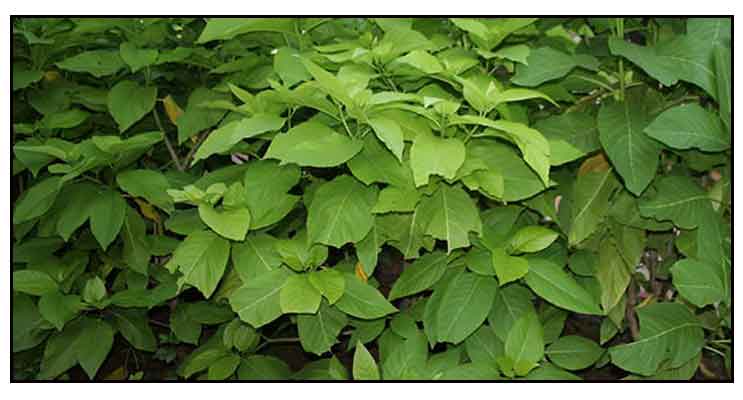 Etymology Etymology
- The common name "bird catcher tree" may derive from the sticky fruits that readily adhere to the feather of birds, causing entanglement and rendering flight impossible (Priddle & Carlile 1995b). (8)
- Pisonia derives from William Piso, a Dutch physician and botanist while the specific epithet umbellifera derives from Latin umbelliferum, umbel bearing or shade carrying.
 Botany Botany
Maluko is an erect, unarmed, smooth or nearly smooth tree, attaining a height of 10 meters. Leaves are thin, very pale green or greenish yellow - those at the end of branches being nearly white- oblong-ovate, 12 to 15 centimeters long, with pointed apex and rounded base. Flowers are borne in terminal, dense, corymbose cymes. Male flowers are white or greenish-white, about 6 millimeters long. Female flowers are smaller. Fruit is long-pedicelled, club-shaped, 12 to 18 millimeters long, 5-angled, each angle bearing one row of prickles.
Distribution
- Ornamental cultivation for its yellow leaves.
- Grown as hedge plant.
- Seldom flowering in the Philippines.
- Native to Indonesia, Malaysia, Thailand,
Vietnam, China, Australia.
- Cultivated in India and Sri Lanka.
Constituents
- Methanolic extract of stem of Pisonia umbellifera yielded three new compounds, secopisonic acid, 6,8-dimethylisogenistein, and (+)- ENT-ficusol, with four first isolates from nature, pisoninol I, pisoninol II, pisoquinoline and pisodienone, together with 15 known compounds. (See study below) (6)
- Study yielded six saponins from the leaves of P. umbellifera. Their structures were determined as 3-O-{beta-D-glucopyranosyl(1-->2)[beta-D-glucopyranosyl (1-->2)-beta-D-xylopyranosyl(1-->3)]-beta-D-glucuronopyranosyl} 28-O-beta-D-glucopyranosyl olean-12-en-3 beta-ol-28-oic acid, 3-O-{2'-(2"-O-glycolyl)-glyoxylyl-beta-D-glucuronopyranos yl} 28-O-beta-D-glucopyranosyl olean-12-en-3 beta-ol-28-oic acid, and 3-O-{2'-O-glycolyl)-glyoxylyl-beta-D-glucuronopyranosyl++ +} olean-12-en-3 beta-ol-28-oic acid. (9)
- Phytochemical screening of ethanol (E) and aqueous (A) leaf extracts yielded alkaloids (E), flavonoids (EA), terpenoids (E), phenol (EA), tannins (EA), reducing sugar (EA), saponins ((EA), steroids (A), quinones (E), glycosides (EA). (see study below) (12)
Properties
- Considered carminative, anti-inflammatory.
- Studies have suggested antidiabetic, antioxidant, anti-tubercular properties..
- Studies have suggested anti-inflammatory, blood glucose lowering, antioxidant, hepatoprotective, antitubercular properties.
Parts used
Leaves
Uses
Edibility
- In Sri Lanka and Bombay, young tender lettuce-tasting leaves are eaten.
- In the Philippines, leaves used for cooking fish wrapped in it.
Folkloric
- Fresh leaves moistened with Eau-de-Cologne used to subdue elephantoid inflammation of the legs.
- Leaves cooked or eaten by people suffering from arthritis or rheumatism.
- Leaves used as carminative, to expel flatulence.
- In traditional Indian medicine, used as an anti-diabetic, anti-inflammatory; used in the treatment of algesia, ulcer, dysentery and snake bites.
Others
- Salt made from ashes of leaves and bark is added to herbal concoctions.(11)
- Agroforestry: Leaves used as green manure. (11)
Studies
• Blood Glucose Lowering / Antioxidant: Treatment of alloxan diabetic wistar rats with P. alba extracts caused a significant reduction of blood glucose levels. It also exhibited potent antioxidant effects on DPPH assay testing. There was also near-normal restoration of histological architecture of the liver, kidney and pancreases in the alloxan-induced diabetic rats. (1)
• Anti-Diabetic / a-Glucosidase inhibitory Activity: Extract exhibited a-glucosidase inhibitory activity in a concentration-dependent manner. Results indicate P. alba extract is effective in hyperglycemia and also protects from metabolic aberrations caused by alloxan. (2)
• Subacute Toxicity Study: Study showed the crude extract of P. alba leaves at the dose of 2 g/kg has not toxic effect on the liver and heart of rats. (3)
• Silver Nanoparticles / Leaf Extract: Metal nanoparticles have unique optical, electronic, mechanical, magnetic and chemical properties. Nanotechnology impacts all spheres of human life. An effective technique for the reduction of silver into silver nanoparticles was achieved using the ethanolic extract of leaves of Pisonia grandis R. Br (synonym Pisonia alba). (5)
• Chemical Constituents / Antitubercular: Methanolic extract of stem of Pisonia umbellifera yielded three new compounds, secopisonic acid (1), 6,8-dimethylisogenistein (2), and (+)- ENT-ficusol (3), with four first isolates from nature, pisoninol pisoninol II, pisoquinoline and pisodienone, together with 15 known compounds. Seven of the isolates showed antitubercular activities against Mycobacterium tuberculosis H37R(V) in vitro with MC ≤50 µg/mL. (6)
• Hepatoprotective: Study evaluated the hepatoprotective effects of P. alba and C. halicacabum against toxicity effects of herbicide atrazine on lipid peroxidation and some antioxidant enzyme system in freshwater fish Labeo rohita. Results showed PA and CH both exhibited significant hepatoprotection against herbicide atrazine induced toxicity in fresh water fish L. rohita. (10)
• Anti-Inflammatory / Leaves: Study screened for phytochemical constituents and evaluated for anti-inflammatory activity of P. umbellifera leaf extracts. Results showed potent anti-inflammatory activity using inhibition in albumin denaturation assay. (see constituents above) (12)
• Lignans and Isoflavonoids / Cytotoxicity / Anti-Inflammatory /Stems: Study of stems isolated 12 new compounds including four isoflavonolignans (1a/1b and 2a/2b), two neolignans (3a/3b) and six isoflavonoids (5-10), together with seven known compounds (4 and 11-16). Compounds 13 and 15 showed moderate in vitro anti-inflammatory activities, and compound 5 exhibited strongest activity against K562 cell line. (13)
Availability
Wild-crafted.
|

![]()




 Botany
Botany